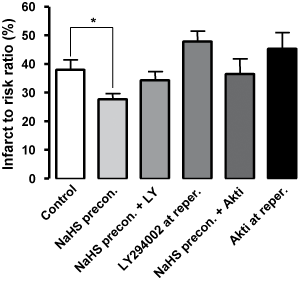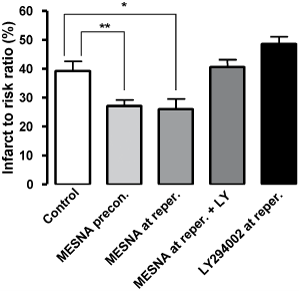079P Brighton
Winter Meeting December 2008 |
H2S-induced cardioprotection is mediated by PI3K activation at reperfusion
David Elsey1, Robert Fowkes2, Gary Baxter1
1Cardiff University, Cardiff, UK, 2The Royal Veterinary College, London, UK
The gaseous mediator, hydrogen sulphide (H2S) is produced predominantly by the enzyme cystathionine-γ-lyase (CSE) (Hosoki et al., 1997) and is derived from metabolic pathways that control the tissue concentrations of sulphur-containing amino acids. H2S has been detected in the myocardium, but as yet its physiological relevance remains unclear. H2S. Recently, it has been reported that administration of the H2S donor, NaHS, at reperfusion was protective (Zhu et al., 2007). We hypothesised that H2S provides protection against reperfusion injury by activating the pro-survival phosphatidylinositol-3-kinase (PI3K) pathway at reperfusion.
Male Sprague Dawley rats (270-350g) were anaesthetised with pentobarbital sodium (60 mg/kg i.p.) and their hearts were Langendorff-perfused. After 35 min regional ischaemia and 120 min reperfusion, triphenyltetrazolium and Evans’ blue double-staining was used to measure infarct size. Hearts were randomised to no drug treatment (control) or were perfused with Krebs’ buffer containing the H2S donor NaHS (50 μM) at early reperfusion only, or during early ischaemia, or as a 5 min preconditioning stimulus (with washout prior to ischaemia). In a further study, hearts were perfused with 2-mercaptoethanesulphonate (MESNA, 50 μM) as a putative thiol/H2S donor either at early reperfusion or as a 5 min preconditioning stimulus. The effects of the PI3K inhibitor LY294002 (10 μM) and Akt inhibitor, Akti VIII (2 μM), given at reperfusion, were examined in NaHS preconditioned hearts. Co-perfusion of MESNA and LY294002 at reperfusion was also investigated. Infarct sizes are shown in figure 1 (NaHS) and figure 2 (MESNA):
Figure 1.

Figure 2.

(*p<0.05, **p<0.01 1 way ANOVA, n=5-15 per group)
These findings suggest that preconditioning the myocardium with H2S (NaHS or MESNA) induces protection against a subsequent ischaemia-reperfusion episode, with a mechanism that appears to involve activation of P13Kinase and Akt at reperfusion.
Hosoki R et al. Biochem Biophys Res Commun, 1997; 237: 527-531
Zhu Y et al. J. Appl Physiol, 2007; 102: 261-26
|



